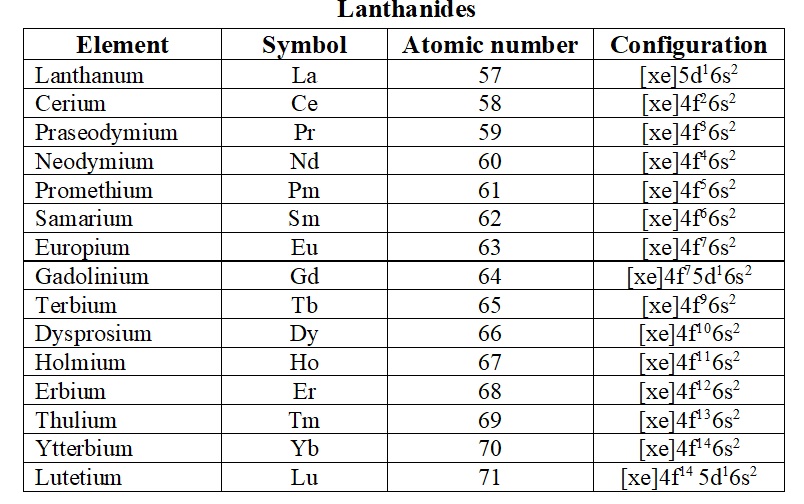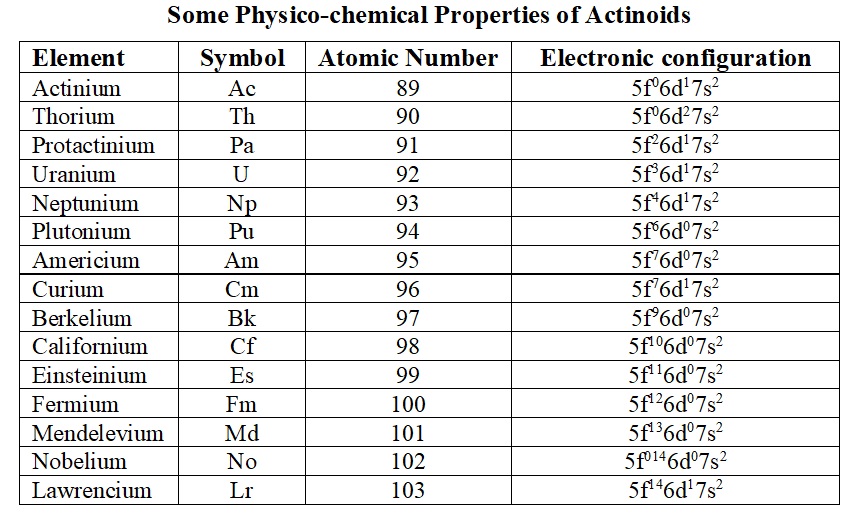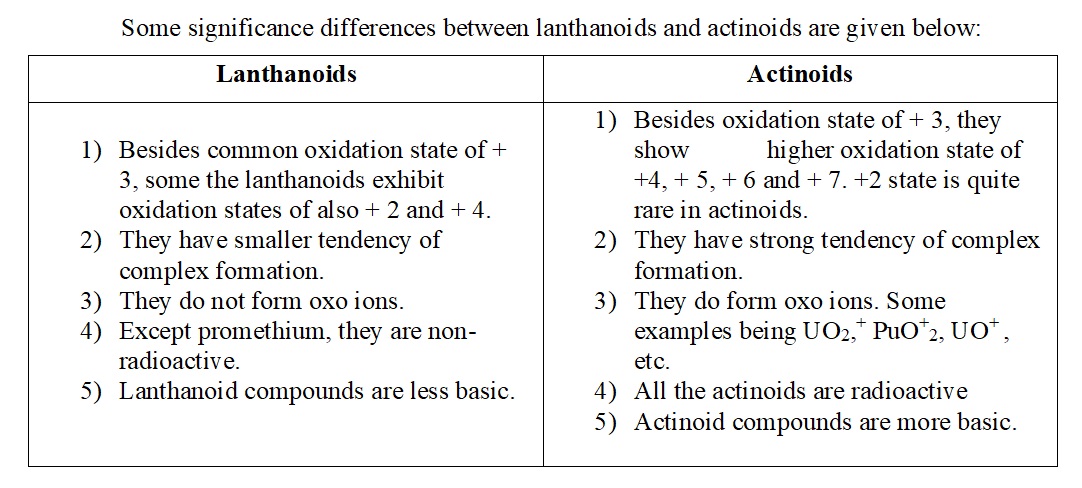f-Block Elements:
The f-block elements are those which have partly filled f-sub-shells of the third to the outermost (antepenultimate) i.e. (n-2) energy shells in their elementary or ionic state. These elements are also called inner transition elements because they form a transition series within the transition elements. The general electronic configuration of f-blocks is (n-2) f1-14(n-1) d0-1ns2. They are also called rare earth elements. These are divided into two series, namely-
- The lanthanide or lanthanoid series
- The actinide or actinoid series.
Lanthanide or lanthanoid series:
Lanthanoids involve the filling of 4f-orbitals in their atoms. These f-orbitals belong to the shell third from the outer shell. This factor accounts for some characteristic properties of these elements. Lanthanum, the first member of lanthanoid has the configuration of 5d16s2 and next member cerium, has 4f26s2 while the next element praseodymium has the configuration 4f36s2. Although lanthanum itself does not possess any 4f electrons, it is customary to include this element in the series. The electronic configurations of the elements with fully filled (f14) and half-filled (f7) f-orbitals are relatively more stable. The extra stability of half-filled orbitals is seen in the elements europium (4f76s2) and gadolinium (4f7 5d1 6s2). The element ytterbium has fully-filled f-orbitals with the configuration 4f14 6s2 and the extra electron in lutetium goes in 5d orbitals (4f7 5d1 6s2). So except for lanthanum, gadolinium and lutetium which have a single electron in 5d orbitals the lanthanoids do not have electrons in the 5d- orbitals.

Physical and Chemical Properties:
Lanthanoids are silvery white metals having low tensile strengths. They are good conductors of heat and electricity. Some of their physical properties are given below:
Density:
Lanthanoids have high densities ranging between 6.77 to 9.74 g cm-3. The densities, in general, increase with increase in atomic number.
Melting and Boiling Points:
Lanthanoids have fairly high melting points. However, no definite trend is observed in melting and boiling points from La to Lu.
Ionisation Energies:
Lanthanoids have fairly low ionisation energies. The 1E1 and 1E2 values are quite comparable to those of alkaline earth metals particularly calcium.
Electropositive Character:
Lanthanoids have high electropositive character due to low ionisation energies.
Coloured Ions:
Many of the lanthanoid ions are coloured in solid state as well as in solutions. The colour is attributed to f-f transitions since they have partly filled f-orbitals. La+3 (4f 0) and Lu+3 (4f14) ions do not show any colour due to vacant and fully filled 4f sub-shell respectively.
Magnetics Behaviour:
The lanthanoid ions (M+3) generally show paramagnetism due to the unpaired electrons in f-orbitals.
Atomic/Ionic Radii and Lanthanoid Contraction:
The atomic radii and ionic radii of tripositive lanthanoid ions (M3+) show a steady and gradual decrease in moving from La to Lu. Although the atomic radii do show some irregularities but ionic radii decrease steadily from La to Lu. The steady decrease in the size of lanthanoid ions (M3+) with the increase in atomic number is called lanthanoid contraction.
Cause of Lanthanoid Contraction:
As the atomic number increases in lathanoid series, for every proton in the nucleus the extra electron goes to fill 4f-orbitals. The 4f-electrons constitute inner shells and are rather ineffective in screening the nuclear charge. Thus, there is a gradual increase in the effective nuclear charge experienced by the outer electrons. Consequently, the attraction of the nucleus for the electrons in the outermost shell increases as the atomic number of lanthanoids increases and the electron cloud shrinks. This results in gradual decrease in size of lanthanoids with increase in atomic number.
Consequences of Lanthanoid Contraction:
Some significant consequences of lanthanoid contraction are given below:
Similarity of Second and Third Transition Series. The atomic radii of second row of transition elements are almost similar to those of the third row of transition elements. For example, among the elements of group 3, there is normal increase in size from Sc toY to La. But after lanthanoids the atomic radii from second to third transition series do not increase as shown below for groups 4 and 5.
Here the usual increase in size on moving down the group from second to third transition elements is cancelled by the decrease in size due to lanthanoid contraction. Also as a result of lanthanoid contraction the second and third rows of transition elements resemble each other more closely than do the first and second row.
Separation of Lanthanoids. Separation of lanthanoids is also possible due to lanthanoid contraction. All the lanthanoids have quite similar properties and due to this reason they are difficult to be separated. However, because of lanthanoid contraction their properties (such as ability to form complexes) vary slightly. This slight variation in properties is utilized in the separation of lanthanoids by ion exchange methods.
Variation in Basic Strength of Hydroxides:
The basic strength of hydroxides decreases from La(OH)3 to Lu(OH)3. Due to lanthanoid contraction size of M3+ ions decreases and there is increase in the covalent character in M—OH bond.
Oxidation States:
The lanthanoids exhibit a principal oxidation state of +3. The +3 oxidation states in lanthanum, gadolinium and lutetium are especially stable because +3 ions of these elements have an empty, a half-filled and completely filled 4f sub-shell respectively. Cerium and terbium also exhibit oxidation state of + 4. Ce4+ has configuration 4f° and Th4+has the configuration 4f7. Sm2+ (4f6), Eu2+ (4f7) and Yb2+ (4f14) ions also exist in aqueous solutions. Although a few lanthanoids exhibit oxidation states of +4 and + 2, yet they have the tendency to attain the oxidation state of+ 3 because the +3 oxidation state is most stable state for all lanthanoids. For example, Ce4+ is a good oxidising agent while Sm2+ is a good reducing agent.
Ce4+ + Fe2+——— Ce4+ + Fe3+
2 Sm2+ +2H20——2Sm3+ +20H– +H2
In the above reactions, Ce4+and Sm2+ are converted into + 3 ions, Ce3+ and Sm3+ respectively.
Chemical Reactivity:
Many lanthanoids react with carbon to form salt-like carbides and with hydrogen to give salt like hydrides. Lanthanoids react with oxygen and sulphur to form oxides (M2O3) and sulphides (M2S3) respectively. Cerium gives CeO2. The M2O3 oxides react with water to form insoluble hydroxides. Oxides and hydroxides on reaction with CO2 give carbonates; M2(CO3)3. Lanthanoid compounds are generally ionic. These compounds are generally coloured and exhibit paramagnetism. These elements occur together in nature because of their great chemical similarity and are difficult to separate. However, because of lanthanoid contraction they do exhibit slight variation in their properties and this becomes the basis of their separation by ion-exchange methods.
Uses of Lanthanoids
The alloys of lanthanoids with other metals find large number of applications in industries. Some common uses of lanthanoids and their compounds are listed below:
- Mischmetal, an alloy which contains rare earth elements (94—95%), iron (5%) and traces of sulphur, carbon, silicon, calcium and aluminium. The main rare earth elements present in this alloy are cerium (40%), lanthanum and neodymium 44%). It is pyrophoric and is used in cigarette and gas lighters, flame throwing tanks, tracer bullets and shells.
- An alloy containing magnesium and about 3% mischmetal is used in jet engine parts.
- Ceric sulphate, Ce(S04)2 is used as oxdising agent in volumetric analysis.
- Cerium salts are also used in dying cotton, in lead accumulators and also as catalysts.
- La2O3 is used in Crooke’s lenses, which give protection from ultra-violet light by absorbing it.
- Many lanthanoid oxides are used as phosphors in colour TV tubes.
- CeO2 is used to polish glass.
Actinides or Actinoid series:
Actinoids involve the filling of 5f-orbitals in their atoms. These f-orbitals belong to the shell third from the outer shell. This factor accounts for some characteristic properties of these elements.
The series of elements involving the filling of 5f-orbitals is called actinoid series. They follow Ac (89) and include elements from Th (90) and Lw (103).
The chemistry of actinoids is more complicated due to the existence of greater range of oxidation states for these metals. Moreover, all these metals are radioactive and therefore, their accessibility for laboratory investigations is limited. The elements beyond uranium are all man made elements and are made by nuclear-chemical methods. Some of the physico-chernical proper ties of actinoids are discussed as follows.
 Oxidation States:
Oxidation States:
The common oxidation state of these elements is + 3. However, they also exhibit oxidation state of + 2, + 4, + 5, + 6 and + 7.
The maximum oxidation state increases from +4 in Th to +7 in Np and Pu. Actinoids form more compounds in +3 state than in the + 4 state. In this respect they resemble lanthanoids. The lower oxidation states tend to be ionic while the higher ones are covalent. +2, +3 and +4 ions are hydrolysed quite readily.
Physical Appearance: Actinoids are silvery white metals. They get tarnished when exposed to the attack of alkalis.
Density: All the actinoids except thorium and americium have high densities.
Colour: The actinoid ions in general, are coloured. The appearance of colour depends upon the number of 5f-electrons. The ions containing 5f° and 5f7 configurations are colourless. While those having 2 to 6 electrons in 5f-shell are coloured.
U3+ (5f 3): Red, Np3+ (5f 4): Bluish, Pu3+ (5f5): Blue, Am3+ (5f 6): Pink
Ionization Energies: IE values of actinoids are low.
Electropositive Character: All the known actinoid metals are highly electropositive. They resemble lanthanoid series in this respect.
Melting and Boiling Points: They have high melting and boiling points. They do not follow regular gradation of melting or boiling points with increase in atomic number.
Magnetic Properties: The actinoid elements are paramagnetic due to the presence of unpaired electrons.
Radioactive Nature: All the actinoids are radioactive in nature.
Actmoid Contraction:
The size of atom/cation decrease regularly along the actinoids series. The steady decrease in ionic radii with increase in atomic number is referred to as actinoid contraction. This is due to poor shielding of 5f-electrons.
Chemical Reactivity:
The actinoids are reactive metals like lanthanoids. They tarnish in air due to formation of oxide coating. They react with hot water. The actinoids react with most non-metals (such as oxygen, hydrogen, halogens) at moderate temperatures. These metals react readily with HC1 but reaction with nitric acid is slower due to formation of protective oxide film. The metals are basic and do not react with NaOH.
Differences between Lanthanoids and Actinoids:

Uses of Actinoides:
Some important uses of actinoids are as follows-
- Thorium is used in atomic reactors as fuel rods and in the treatment of cancer. A mixture of thorium and cerium nitrate in the ratio of 99: 1 is used for making incandescent gas mentles.
- Uranium is used as nuclear fuel. Its salts are used in glass industry (for imparting green colour), textile industry and also in medicines.
- Plutonium is used as fuel for atomic reactors as well as in atomic bombs.